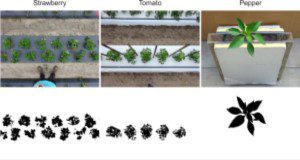Counts (e.g., number of leaves, fruits, seeds, or plants) are a common type of data gathered in horticultural research. In many instances, using ImageJ can increase the ease and accuracy of gathering count data. When image processing can easily separate objects of interest from the background, automatic counting with ImageJ can eliminate tedious manual counting processes. Furthermore, additional plant growth data, such as leaf area, plant width, and canopy area, can be collected from the same image. The image processing and analysis techniques introduced in this article are easily accessible and simple to use and thus can be adopted not only by researchers, but also by Extension agents and students. This new 10-page publication of the UF/IFAS Horticultural Sciences Department is part of a series introducing various image-based measurements with ImageJ for horticultural research. Written by Lillian Pride and Shinsuke Agehara.
https://edis.ifas.ufl.edu/hs1405
Tag: ImageJ
A Simple, Inexpensive, and Portable Image-Based Technique for Nondestructive Leaf Area Measurements
This new 6-page article, part of a series introducing various image-based measurements for horticultural research, introduces a simple, inexpensive, and portable image-based technique for nondestructive leaf area measurements. It uses an imaging apparatus made with ordinary office supplies to obtain leaf images in greenhouse or field environments. Leaf images are then processed and analyzed to measure leaf area using ImageJ, an open-source image processing program. Because both image capture and analysis are performed nondestructively, leaf area can be measured on the same leaf repeatedly, enabling the monitoring of leaf growth over time, as well as photosynthesis and transpiration. This technique is particularly useful to researchers and students studying leaf growth and physiology in greenhouse or field environments. Written by Shinsuke Agehara, Lillian Pride, Mariel Gallardo, and Jose Hernandez-Monterroza, and published by the UF/IFAS Horticultural Sciences Department.
https://edis.ifas.ufl.edu/hs1395
How to Measure Leaf Disease Damage Using Image Analysis in ImageJ
This new 13-page article introduces simple image processing and analysis techniques to quantify leaf disease damage using ImageJ, an open-source image processing program. These techniques are not meant to replace crop scouting or disease diagnosis by a plant diagnostic laboratory, but rather to provide a supplemental tool for making quantitative measurements of leaf disease damage. Similar techniques are also available for plant growth assessment, including plant height, plant width, and canopy cover area. The image processing and analysis techniques introduced in this article are fairly simple to use and thus can be adopted not only by researchers, but also by producers, crop consultants, Extension agents, and students. Written by Lillian Pride, Gary Vallad, and Shinsuke Agehara, and published by the UF/IFAS Horticultural Sciences Department.
https://edis.ifas.ufl.edu/hs1382
Simple Imaging Techniques for Plant Growth Assessment
Quantification of plant phenotypic traits, such as height, width, stem diameter, and leaf area, is often performed manually in the field; however, these measurements can be performed more quickly and precisely through simple imaging techniques using an image processing program. This new 5-page publication of the UF/IFAS Horticultural Sciences Department, written by Shinsuke Agehara, describes simple imaging techniques for plant growth assessment using the public domain program ImageJ.
https://edis.ifas.ufl.edu/hs1353



